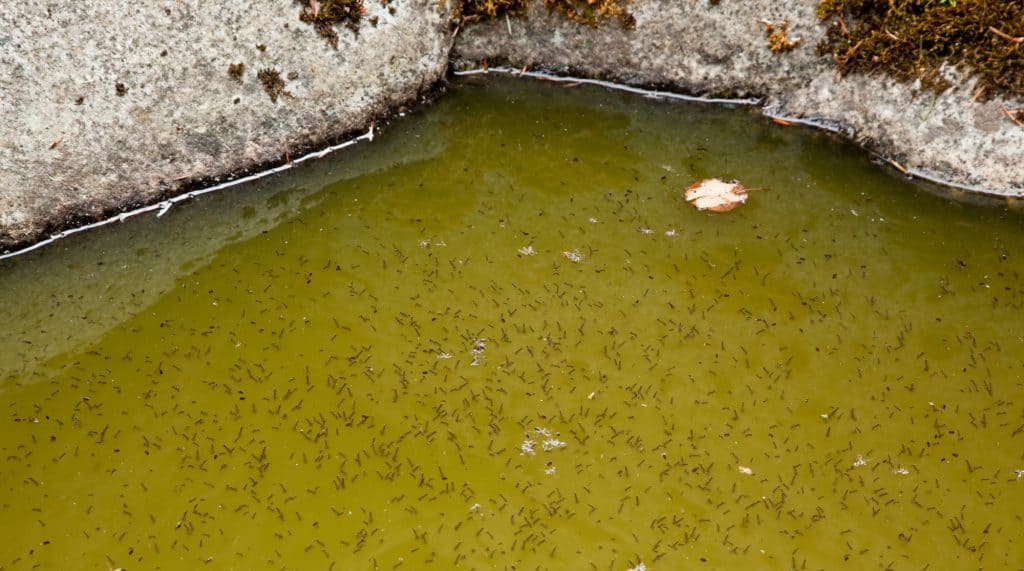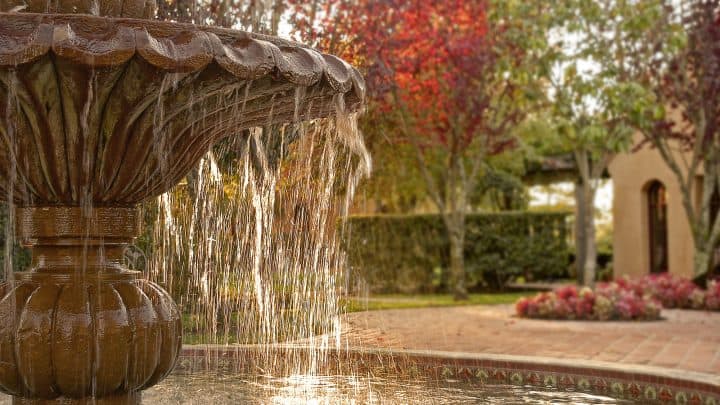Outdoor water features such as ponds, fountains, and waterfalls make a beautiful addition to your yard, but are they easy to clean? Why is it that outdoor water features sometimes smell?
You can stop outdoor water features from smelling through regular cleaning, providing fresh water, proper aeration, and maintaining a healthy ecosystem. The smell may be due to anaerobic bacteria, decaying matter, and dirt. Therefore, combating these causes is essential to remove the problematic scent.
There are many reasons why your outdoor feature may smell foul. To truly address the problem, you need to first understand these reasons and then know how to deal with them.
Why Does My Outdoor Water Feature Smell?
Knowing the cause behind your water feature’s foul smell can help you better resolve the issue.
Outdoor water features may smell because of the lack of filters, accumulation of matter, lack of aeration, and too many algae. Some reasons may be more obvious, such as decaying matter, as seen by the presence of dark sludge. Lack of aeration can promote anaerobic bacteria growth, which results in an unpleasant smell.
Lack of Maintenance or Filtration System
The lack of maintenance or filtration systems may allow organic matter to accumulate. Maintenance, such as deep cleaning, can be conducted every few months only if proper equipment, like filters, is in place. Otherwise, it may have to be done more often.
Filters do not just keep dirt and matter from entering the water feature; they also help process waste from organisms like fish. Along with a pump, they help avoid the waste buildup that causes most foul smells.
Accumulation of Decaying Matter and Debris
Leaves, dirt, organic waste, twigs, and dead organisms are just some of the decaying matter and debris that may contribute to sludge formation. While normal, it can be pretty smelly if the decaying matter accumulates.
The best way to solve this problem is by taking care of your leaf problem early.
Dead organisms, such as fish and plants, can have more foul odors. Moreover, they may release harmful substances, such as ammonia, affecting the remaining living organisms.
Therefore, it is essential to regularly monitor your water features to prevent this buildup of decay.
Lack of Aeration
Lack of aeration due to stagnant water or the absence of pumps may lead to the proliferation of anaerobic bacteria. These bacteria survive in places with depleted levels of oxygen. They also break down waste in the pond and release harmful and smelly by-products, such as hydrogen sulfide.
Furthermore, pumps keep harmful substances from accumulating and allow aerobic bacteria to thrive, which can act as natural filters. They also help keep water fresh and circulate cleaning chemicals.
Overabundance of Algae
While algae can act as a natural filter, too much of it can deplete oxygen and lead to a lack of aeration, which affects the aerobic bacteria. When these bacteria die, there are fewer organisms that can process waste. Furthermore, dead algae can also decay and contribute to the stink.

How Do I Keep My Outdoor Water Feature From Smelling?
Regular cleaning, fresh water, and proper equipment are essential in keeping your outdoor water feature from smelling. You also need to remove debris and matter before and when it starts to stink. Proper winter preparation is also essential to avoid dying fish or waste buildup.
Regular Cleaning and Maintenance
When your water feature starts to stink, you should clean it without delay.
First, scrub off all the grime and muck. You can use cleaning chemicals, like bleach or fountain chemicals, vinegar, or mild soap and sponge in the process.
Also, be sure to also remove the pumps and clean them. The stink may be eliminated by removing all the buildup waste and replacing it with fresh water.
Maintenance is crucial in keeping your pond from smelling foul. Schedule regular cleanups every few weeks or months. Replace the water regularly and make sure to check if equipment, like filters or pumps, need cleaning or replacement.
Keep Water From Being Stagnant
Stagnant water can lead to a lack of aeration, which leads to thriving anaerobic bacteria and waste buildup. It may also be a potential breeding ground for mosquitoes. Hence, you should not allow water to stagnate.
You can avoid this by incorporating pumps or filling the feature with fresh water. While you’re at it, you can read up on how to conserve water for your outdoor fountain.
Invest in Necessary Equipment To Keep It Clean
Having the right equipment does not just keep your water feature from smelling bad; it also helps you avoid cleaning all too often. Hence, investing in suitable materials is crucial for maintenance. Here are a few items that you should consider incorporating into your system:
- Filtration system: Filters are especially crucial when the water feature has organisms, such as a fish pond. These organisms can produce waste that natural filters cannot break down or process as fast as filtration systems. These filters can help avoid buildup, keeping the water fresh and healthy for the population; thus, avoiding it from smelling foul.
- Water pumps: Water pumps are essential in keeping a water feature well-aerated and keeping anaerobic bacteria from thriving. They prevent water from stagnating and keep it fresh. However, you should get them in the right size or type to ensure that it has the needed capacity to pump the right amount of water in your feature.
- Cleaning chemicals: There are many cleaning chemicals available for water features. These chemicals may make cleaning and maintenance more manageable, but make sure they are animal-friendly if you have fish, frogs, or other organisms living in your water feature. Also, make sure that it is compatible with your water feature’s material.
Remove Decaying Plants and Animals From the Water
Removing decaying organisms from water does not just make it clean and remove the foul smell; it also helps prevent further contamination and break down of harmful substances.
These dead organisms can release ammonia, which can further harm the ecosystem. Dead organisms may also indicate something is wrong with your water features, like high waste or harmful gas levels.
Maintain a Healthy Algae Population
Algae are not harmful and may even be beneficial as they can serve as a natural filtration system. It may even provide a food and oxygen source for organisms. However, they should be kept at a healthy population, and algal blooms should be treated immediately to prevent crowding, decaying material, and oxygen depletion.
You can place your water feature in the shade to avoid direct sunlight. Sunlight promotes algae growth, and limiting it may help limit the population.
Prepare for Winter
When spring rolls in, many might find themselves greeted by a foul smell in their water feature. That may be because proper preparation for winter was not done. Before the cold season begins, it may be ideal to do cleaning to avoid buildup. Buildup can also harm fish during winter.
You can use a de-icer to ensure that gas exchange and proper aeration are still in place for your fish. In doing so, you may avoid fishkill.
Final Thoughts
Having a water feature installed is easy but cleaning up the very stinky muck when all the waste is allowed to build up is not a fun job. However, you can avoid that by conducting proper maintenance, having the right equipment, and keeping your water feature ecosystem healthy.
By keeping in mind all of these tips, you can better enjoy the sight and sound of your pond or fountain without worrying about its smell.
Sources
- Wikipedia: Water feature
- Gardening Know How: What Is A Water Feature: Types Of Water Features For Gardens
- Water Feature Pros: What’s That Smell? What to do About It
- Pond Informer: How to Fix Smelly Pond Water (Safe & Easy Treatments)
- Blagdon: Dirty Self Contained Water Feature
- WikiHow: How to Keep Algae out of Water Fountains
- SFGATE: How to Prevent Algae in Garden Fountains
- This Old House: 5 Tips for Maintaining Garden Fountains
- Serenity Health & Home Decor: Water Fountain Care Tips
- Backyard Way: How Much Vinegar to Add to Your Water Fountain

